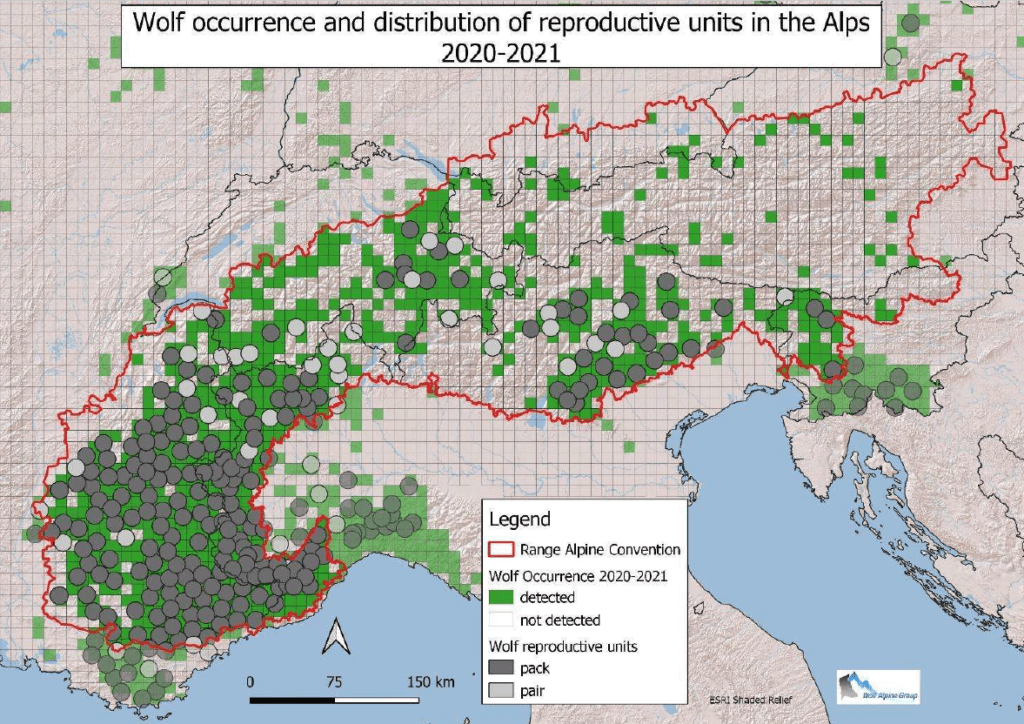The status of the Alpine wolf population
The Alpine wolf population estimate documents the presence of 206 packs and 37 pairs, with a total of 243 reproductive units distributed across the entire Alpine arc, from west to east. This is the result of the assessment of the status of the Alpine wolf population carried out by the international expert group Wolf Alpine Group (document available on our website at this link).
The Alpine wolf population occupies the entire Alpine arc and covers seven different countries, but from an ecological point of view it is a single population. Wolves don’t know our administrative borders and are animals that can travel long distances, so it makes little sense to talk about wolves in a single country and even less in individual regions, which is why monitoring within the LIFE WolfAlps EU project is coordinated and standardised.
In the spirit of cross-border cooperation, the Wolf Alpine Group (WAG), a working group of researchers and technicians from Italy, France, Switzerland, Austria, Slovenia and Germany, was established in 2001. The group enables a constant exchange of scientific knowledge on the biology, distribution and status of the wolf population in the Alps, and provides robust population estimates thanks to continuous work on improving monitoring methods. The group meets regularly and its twelfth meeting was held in Barcelonette, France, last December.
Although each state continues to keep its own peculiarities in mind, and conducts its own monitoring at the national level, thanks to the guidelines developed by the WAG, each country collects information that is used to pool data and arrive at a robust estimate of the distribution and abundance of the entire Alpine population.
How do we work together across administrative, linguistic and cultural boundaries? In order to harmonise estimation and monitoring methods as much as possible, standard reference criteria have been defined to classify signs of presence and reports, as well as parameters to be measured to give a numerical quantification of the population. These parameters are: the number of packs (defined as a group of at least 3 wolves defending a territory) and the number of breeding pairs (the female/male pair that has established its territory). Thus, dispersing or solitary wolves are not taken into account in the numerical estimate, but are important for estimating the area over which the population is distributed. In fact, all signs of presence collected during monitoring activities and random reports submitted to individual authorities, if validated with appropriate verification, are taken into account for the production of the map. The monitoring year used for the estimates corresponds to the wolf’s biological year, from 1 May to 30 April of the following calendar year, i.e. from one reproductive event to the next.
Thus, in 2020-2021, 206 flocks and 37 new pairs were recorded, for a total of 243 breeding units. A higher density of flocks is observed in the western Alpine arc, while the expansion in the central-eastern Alpine arc is still ongoing. At the same time, the Dinaric population is expanding northwards. In the western Alpine arc (in the area of France and Italy), the mountain areas have reached saturation point and the population is expanding towards the hills and lowlands.

Considering only the Alpine area within each country, 82 flocks and 16 pairs were documented in Italy, 107 flocks and 11 pairs in France, 8 flocks and 8 pairs in Switzerland and 5 flocks in Slovenia. In addition, 2 transboundary breeding units (1 flock and 1 pair) were documented between Switzerland and Italy, 2 between Italy and France, 1 flock between France and Switzerland and 1 between Italy and Slovenia.
Over the years, the number of herds in the Alpine population has steadily increased. The last population-scale assessment was carried out in 2015-2016 and documented 65 herds and 12 pairs, with higher densities in the western part. Alpine population-scale monitoring and estimation is a complex task requiring a high level of coordination and field effort, and is therefore not feasible on an annual basis, which is why there are gaps between estimates.










